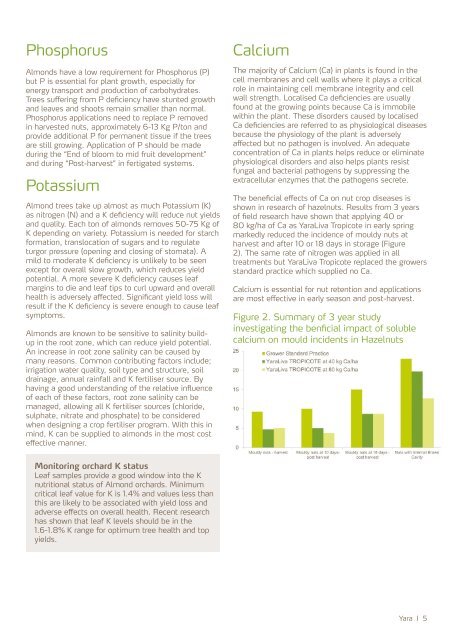The Nutrition of Almonds
The%20Nutrition%20of%20Almonds_HR_tcm583-241357
The%20Nutrition%20of%20Almonds_HR_tcm583-241357
You also want an ePaper? Increase the reach of your titles
YUMPU automatically turns print PDFs into web optimized ePapers that Google loves.
Phosphorus<br />
Calcium<br />
<strong>Almonds</strong> have a low requirement for Phosphorus (P)<br />
but P is essential for plant growth, especially for<br />
energy transport and production <strong>of</strong> carbohydrates.<br />
Trees suffering from P deficiency have stunted growth<br />
and leaves and shoots remain smaller than normal.<br />
Phosphorus applications need to replace P removed<br />
in harvested nuts, approximately 6-13 Kg P/ton and<br />
provide additional P for permanent tissue if the trees<br />
are still growing. Application <strong>of</strong> P should be made<br />
during the “End <strong>of</strong> bloom to mid fruit development”<br />
Calcium improves potato tolerance to diseases<br />
and during “Post-harvest” in fertigated systems.<br />
Potassium<br />
Almond trees take up almost as much Potassium (K)<br />
as nitrogen (N) and a K deficiency will reduce nut yields<br />
and quality. Each ton <strong>of</strong> almonds removes 50-75 Kg <strong>of</strong><br />
K depending on variety. Potassium is needed for starch<br />
formation, translocation <strong>of</strong> sugars and to regulate<br />
turgor pressure (opening and closing <strong>of</strong> stomata). A<br />
mild to moderate K deficiency is unlikely to be seen<br />
except for overall slow growth, which reduces yield<br />
potential. A more severe K deficiency causes leaf<br />
margins to die and leaf tips to curl upward and overall<br />
health is adversely affected. Significant yield loss will<br />
result if the K deficiency is severe enough to cause leaf<br />
symptoms.<br />
<strong>Almonds</strong> are known to be sensitive to salinity buildup<br />
in the root zone, which can reduce yield potential.<br />
An increase in root zone salinity can be caused by<br />
many reasons. Common contributing factors include;<br />
irrigation water quality, soil type and structure, soil<br />
drainage, annual rainfall and K fertiliser source. By<br />
having a good understanding <strong>of</strong> the relative influence<br />
<strong>of</strong> each <strong>of</strong> these factors, root zone salinity can be<br />
managed, allowing all K fertiliser sources (chloride,<br />
sulphate, nitrate and phosphate) to be considered<br />
when designing a crop fertiliser program. With this in<br />
mind, K can be supplied to almonds in the most cost<br />
effective manner.<br />
<strong>The</strong> majority <strong>of</strong> Calcium (Ca) in plants is found in the<br />
cell membranes and cell walls where it plays a critical<br />
role in maintaining cell membrane integrity and cell<br />
wall strength. Localised Ca deficiencies are usually<br />
found at the growing points because Ca is immobile<br />
within the plant. <strong>The</strong>se disorders caused by localised<br />
Ca deficiencies are referred to as physiological diseases<br />
because the physiology <strong>of</strong> the plant is adversely<br />
affected but no pathogen is involved. An adequate<br />
concentration <strong>of</strong> Ca in plants helps reduce or eliminate<br />
physiological disorders and also helps plants resist<br />
fungal and bacterial pathogens by suppressing the<br />
extracellular enzymes that the pathogens secrete.<br />
<strong>The</strong> beneficial effects <strong>of</strong> Ca on nut crop diseases is<br />
shown in research <strong>of</strong> hazelnuts. Results from 3 years<br />
<strong>of</strong> field research have shown that applying 40 or<br />
80 kg/ha <strong>of</strong> Ca as YaraLiva Tropicote in early spring<br />
markedly reduced the incidence <strong>of</strong> mouldy nuts at<br />
harvest and after 10 or 18 days in storage (Figure<br />
2). <strong>The</strong> same rate <strong>of</strong> nitrogen was applied in all<br />
treatments but YaraLiva Tropicote replaced the growers<br />
standard practice which supplied no Ca.<br />
Calcium is essential for nut retention and applications<br />
are most effective in early season and post-harvest.<br />
Figure 2. Summary <strong>of</strong> 3 year study<br />
investigating the benficial impact <strong>of</strong> soluble<br />
calcium on mould incidents in Hazelnuts<br />
Monitoring orchard K status<br />
Leaf samples provide a good window into the K<br />
nutritional status <strong>of</strong> Almond orchards. Minimum<br />
critical leaf value for K is 1.4% and values less than<br />
this are likely to be associated with yield loss and<br />
adverse effects on overall health. Recent research<br />
has shown that leaf K levels should be in the<br />
1.6-1.8% K range for optimum tree health and top<br />
yields.<br />
Yara I 5


